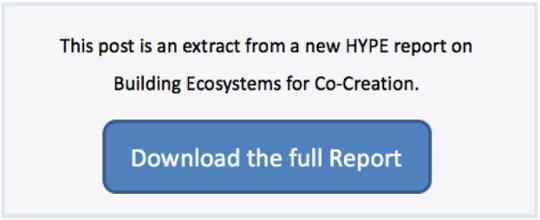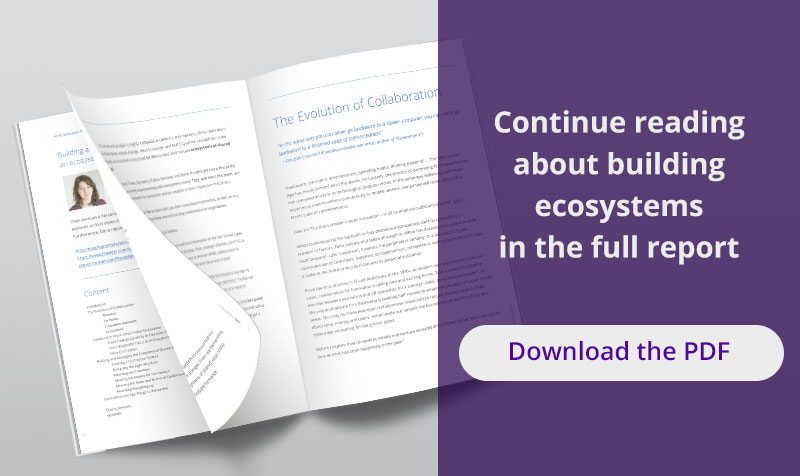“Anything that just costs money is cheap” John Steinbeck - American novelist
Before we move on to see how ecosystems are built and managed, let’s take a moment to grasp their underlying logic. In as follows, a crash course on “goods-dominant” versus “service dominant” logic, customer focus, resilience thinking and value co-creation. In short, the “stuff” ecosystems are made of.
From Product-Centricity to Customer Focus
Thinner paper, better eyeglasses, faster steam engines, smaller mechanized clocks. Oh, and more reliable anaesthesia (ever watched The Knick?). Traditionally, organizations have made product efficiencies their highest priority. Which is hard to condemn. After all, processing, assembly, launch, distribution etc. can all be measured or quantified and put into a production plan. The Stage-Gate idea-to-launch models and other processes like it leverage the latter. Relationship management, by contrast, is more elusive. The “Go/ No Go” decision here can mean lifetime fidelity towards a firm versus lifetime indifference.
Ask any manager about the product versus customer centricity divide and you will get mixed feelings. While some continue to obsess over products’ characteristics (yes, innovation can easily go overboard), others scrutinize customers/users to see whether the product or service can get their jobs done. The two sides have, in fact, their own well-established principles.
In academia the product view is called the “goods-dominant” (G-D) logic, while the customer or service view is known as the “service-dominant” (S-D) logic. Research duo Robert Lusch and Stephen Vargo have written extensively about the topic. For over a decade now, their pioneering thinking, and that of their predecessors, has guided many firms in making a dramatic shift in how they tackle stakeholders and collaboration.
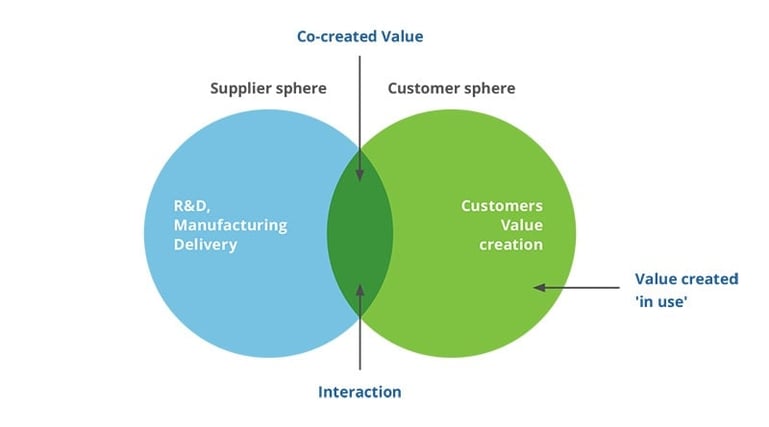 S-D logic is a unique mindset that provides a unified understanding of the purpose and nature of firms. Among other aspects, S-D logic explains:
S-D logic is a unique mindset that provides a unified understanding of the purpose and nature of firms. Among other aspects, S-D logic explains:
- The purpose of a firm’s activity: to assist customers in their own value creation processes as opposed to producing and distributing units of output,
- The basis of inter-firm exchange: people exchange services only,
- The role of the customer: the customer is the creator of value and not a destroyer of it,
- And the role of innovation: innovation means helping customers create value in a more effective way; it does not mean better goods and services alone.
In summary, S-D logic embraces the concepts of “value-in-use” and “co-creation of value” as opposed to “value-in-exchange” and “embedded-value”, typical for G-D logic. As Lusch and Vargo note, “instead of firms being informed to market to customers, they are instructed to market with customers, as well as other value-creation partners in the firm’s value network”.
How does this all relate to ecosystems? Well, the underlying logic of ecosystems is S-D logic. Ecosystems are inherently collaborative.
Let’s keep this last one in mind before going forward.
The Collaborator Focus in an Ecosystem
The “customer is king” is a motto you’ve surely seen and heard. In ecosystems, this focus is critical since all innovative initiatives are directed towards the customer. Moreover, the customers as well as other collaborators are actively contributing to new product/ service/ business model development.
But where does customer focus come from and how should firms understand it?
While many things have contributed to the emergence of the “customer is king” hype, no means were more powerful than IT tools and the Internet. In an article called “The Path to CustomerCentricity”, for example, prof. Denish Shah and his co-authors explain how diverse and better data collection methods (in the final part of the 20th century) helped firms give their customers the attention and decision-making power they deserved. These methods are still very much in use today.
At first, progress with customer focus was slow, uneven and, as you can probably tell, far from genuine. Several decades and countless marketing mistakes later (does Mad Men ring a bell?), learning loops started to work their charm. Today, understanding customers and collaborators and adapting quickly, elegantly and intelligently to their needs is a growing trend.
In brief, having a customer/ collaborator focus is all about:
- Serving customers and not whomever will buy,
- Taking strategic decisions with the customers and collaborators in mind,
- Being relationship and not transaction oriented,
- Creating lasting ties,
- Measuring success in terms of customer satisfaction, customer lifetime value, customer equity and the like.
All in all, the transition from product-centricity to having a full customer focus is in line with the evolution of collaboration. While strategic alliances and portfolios were typically established to improve some aspect of a good or service, networks and ecosystems were devoted to managing relationships and encouraging co-evolution.
But customer or collaborator focus does not mean any co-creation is taking place. A firm can get a customer’s job done, successfully without encouraging co-creation. This is a frequent occurrence in software and FMCG industries, where “new featuritis” or the tendency for the number of features to increase with each release is the norm. More tabs in Adobe Photoshop or more blades on a razor can be signs of customer focus. The practice, however, fails to immerse the customer and other collaborators into the NPD process. Hence, we cannot talk about an ecosystem.
For true co-creation to occur, and for ecosystems to function, a few additional steps need to be followed.
Value Co-Creation
So we’ve just established that in the new paradigm customers and collaborators are no longer passive actors to be sold to, exploited and manipulated by firms. In addition to making a nice quote for the office wall, this statement paves the way for the final notion I’d like to elaborate on: value co-creation.
If we were to draw the two main collaboration logics on a continuum, the traditional goods-dominant logic (product-centricity), would sit to the far left. To the far right, we find service dominant logic (value co-creation). Between these two, slightly closer to cocreation, we find customer focus.
Any firm, irrespective of its industry, can be placed somewhere along this imaginary line. Do this exercise at several points in time and you notice the shift. Or lack of. What is happening here? While some firms embrace co-creation, others fall back on what they know. Furniture manufacturers, chemical firms, computer companies and energy companies have all started by being fully product-centric but are now understanding customer focus and ecosystems of shared value. Take IKEA, Apple, or ENEL – all actively working with customer and stakeholders to provide solutions for better living, better entertainment and sustainable energy solutions.
Furniture manufacturers, chemical firms, computer companies and energy companies have all started by being fully product-centric but are now understanding customer focus and ecosystems of shared value. Take IKEA, Apple, or ENEL – all actively working with customer and stakeholders to provide solutions for better living, better entertainment and sustainable energy solutions.
Fast moving consumer goods companies, sports equipment manufacturers, media and production companies, by contrast, were typically focused on their customers and collaborators to begin with. They are now moving into co-creation. Just look at The Campbell Soup Company,Nike and the Pixar Animation Studios.
Finally, some organizations – a select few – have embraced co-creation directly by innovating in the realm of the so-called Sharing Economy. Uber, Airbnb, Netflix, all let customers and collaborators add to the value co-creation process. The result is a system in which all actors evolve together.
And here is the fundamental difference between customer or collaborator focus and value cocreation.
While the former is all about identifying the needs of the customer and/or collaborators, and then meeting those needs at all cost, the latter invites customers and other stakeholders to make their resources accessible to the ecosystem. Moreover, it considers the ecosystem members (especially the customer) as a distinct source of competence.
In an ecosystem of shared value, customers, competitors, collaborators, complementors and all other categories function as one well oiled machine. Everyone provides input, and everyone derives value. Every member is simultaneously a giver and a receiver of resources and knowledge. Suppliers and customers coincide.
Let’s take two examples.
Ever heard of the Københavns Fødevarefællesskab (KBHFF)? This unpronounceable Danish member-based food cooperative offers locally produced fruits and vegetables to its members in exchange for a little work. The cooperative’s members are all, in fact, coowners of the business, making their stakes equally high.
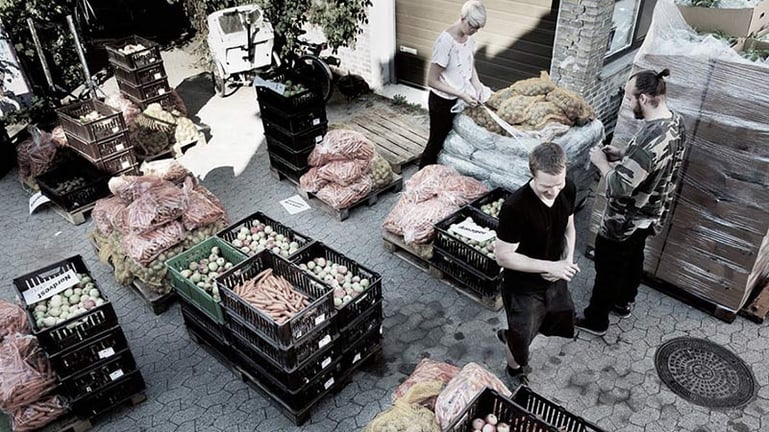
What about ScotRail? The company’s “Adopt a station” program invites citizens and communities to use unoccupied space for the provision of services via bookshops, community centres, cafés, or for facility improvements via gardening and keeping an eye out for the occasional acts of vandalism. So far 260 stations were “adopted” out of about 344, while its popularity is soaring.
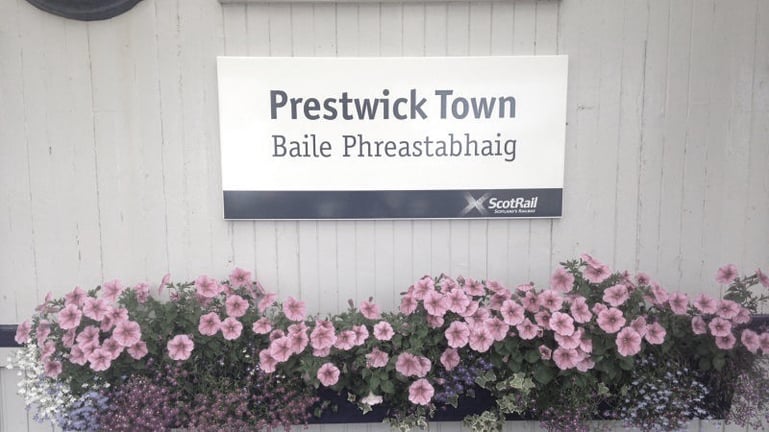
In both cases value co-creation is an integral part of keeping the ecosystems healthy and stable. Customers (growers and passengers) contribute their time and talent to provide themselves and others with organic food and a more pleasurable travel experience. KBFHH and ScotRail, in turn, earn fidelity by sharing leadership and unused assets. Additionally, they have their infrastructure cared for.
Interestingly, value co-creation in ecosystems is as much about the actions that ecosystem members take as they collaborate and governance models they use as it is about language. In healthcare, recent research has been documenting what patient centred care is and is not according to the new paradigms (S-D Logic)
While listening to patients and their families and prescribing activities that will hopefully improve the patients’ outcomes is important, it does not represent co-creation. Co-creation is the “stewardship on the part of the healthcare (eco)system to substantially improve the likelihood that the customer can achieve the job they want to get done”. Subtle, but extremely important.





